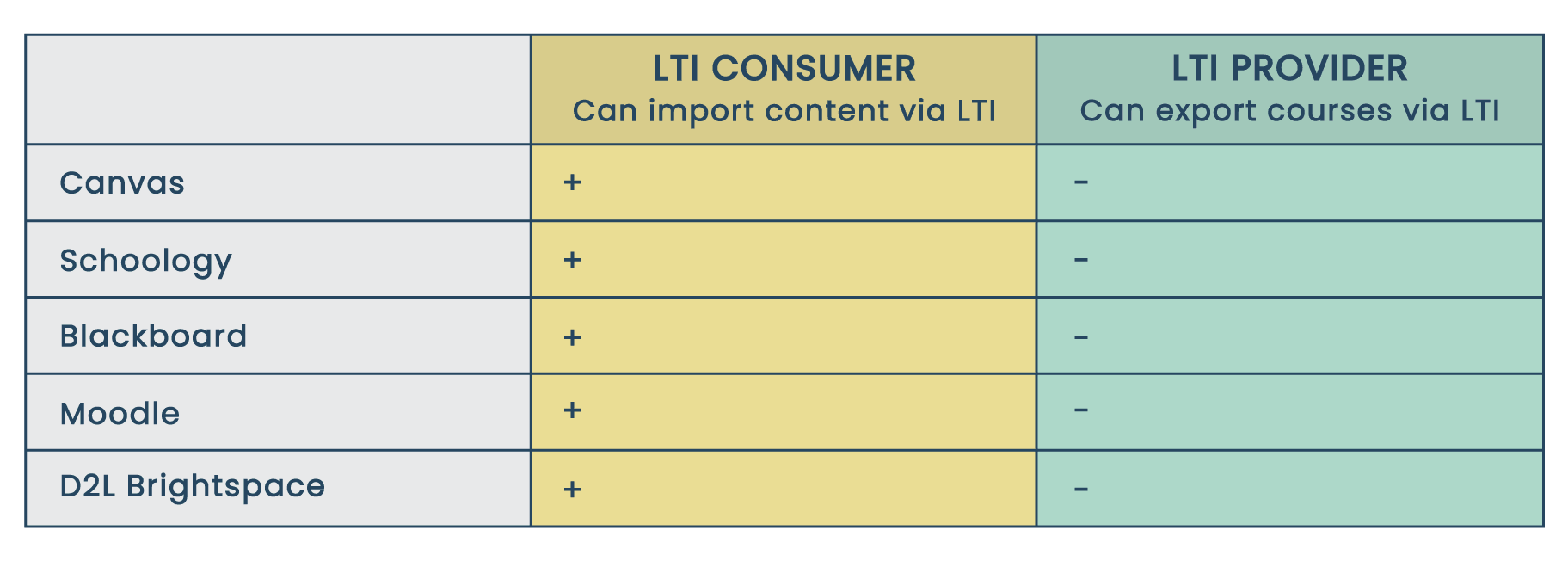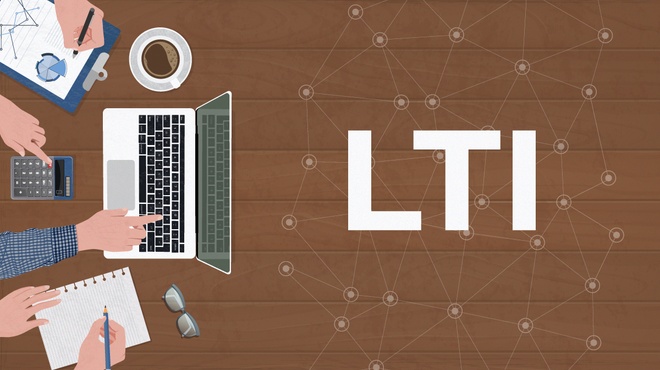How to integrate LMS content with LTI Deep Linking

Some content publishers don’t think too much about their learning management systems. They just get a popular one, like Canvas or Blackboard.
This causes troubles later on. Turns out, there is no simple way to export content from one LMS to another. If you use Canvas and your client has Schoology, it’s hard to get your courses across.
Major learning management systems are designed for schools, not publishers. They can easily import courses from other platforms, but not export them.
But there are workarounds. In this article we’ll cover how to integrate curriculum between different LMSs.
Manual LMS Content Integrations
These are the manual ways to export content from your learning management system to your client’s one. Generally speaking, the better your content is integrated, the better your odds of selling it.
Login. This is the simplest option: let the students log into your application. The problem here is that nobody wants to do that. Remembering different applications and credentials is a hassle.
Most schools will not buy your content if you force users to remember credentials. It’s best to find another way to integrate content.
Single Sign On (SSO). SSO is a step up from regular logins. Users don’t need to remember passwords, they can log in with a button. Think of logging into a website using your Google account. With SSO students can log into one LMS using their account at another LMS.
Most popular SSO methods are OAuth 2, OpenID, and SAML. If both LMSs support a method, you can set up an SSO integration.
The downside is that users still have to remember where they need to log in. If your school buys curriculum from different providers, tough luck remembering when to use Canvas, Schoology, or 5 other LMS.
File exporting works like this: teachers export files from the publisher’s LMS, and import them into the school learning management system.
For students, this option is seamless because they never have to leave their LMS. For everyone else, file exporting is a bit of a pain.
The main problem is keeping content up to date. Administrators will have to keep track of whether a new version is released. But it’s difficult to manually manage hundreds of course versions. As a result, the curriculum is often outdated.
There are 3 main file options for course exporting. Make sure that both learning management systems support your method:
- Common Cartridge (.IMCC files);
- SCORM;
- H5P.
Automatic LMS Integration with LTI Deep Linking
LTI (Learning Tools Interoperability) is a complex standard that connects learning management system with 3rd party learning tools. Some examples of such tools are curriculums, learning games, or simulations.
LTI Deep Linking is one of several Learning Tools Interoperability services. LTI covers many aspects, so feel free to read our guide to LTI.
With LTI Deep Linking, content integration is seamless for everyone. Students and teachers stay within their regular LMS. Publishers don’t have to worry about course versioning, because the curriculum is always synchronized.
LTI Deep Linking requires Learning Tools Interoperability version 1.3. So make sure that your LMS supports Learning Tools Interoperability 1.3 if you’re interested in Deep Linking.
Schools prefer publishers that support Deep Linking because it’s the best way to integrate content. If your learning management system supports Learning Tools Interoperability, you’ll get ahead of competitors.
But there is one problem.
Most LMS Are Not LTI Providers. They Are Only LTI Consumers
LTI is very convenient, but most learning management systems are not designed for publishers.
Hundreds of LMS compete with each other for users. They don’t want students to use a rival platform.
So major LMS can import Learning Tools Interoperability content, but won’t let you export it. In technical terms, these LMS are LTI consumers, but not LTI providers.
Here’s a list of major learning management systems. As you can see, none of them are Learning Tools Interoperability providers.

Which LMS Is an LTI Tool Provider?
This is a huge problem for curriculum publishers. How do you sell content to schools or universities if your LMS can’t export courses?
Even if you try integrating them via API, it still won’t work. Simply because the LMS companies don’t want to be merely authoring tools, they want to be your only LMS solution.
You Have 4 Options
- Don’t use Learning Tools Interoperability. This is what many providers do, they export courses via Common Cartridge. But this is a sure way to lose most of your potential customers who require LTI.
- Stick to clients with the same LMS as yours. If you choose Canvas, you’ll still cover a fair share of the market.
- Get several learning management systems. It can work if your potential customers only have 2 or 3 LMS. You could get both Canvas and Schoology, and duplicate content. But this is a logistical mess.
- Get an LMS integration tool. An LMS that would both import and export curriculum via LTI Deep Linking.
We advocate for the last option. Let’s explore it in more detail.
Integrate Canvas, Schoology, or Any Other LMS

How Aristek eLearning Integration Tool Works
Let’s say you build courses in Canvas, but your customer uses Schoology. Schoology is an LTI consumer, but Canvas is not an LTI provider.
Here’s How It Works When You Get the LMS Integration Tool
- Import existing courses into the tool from your LMS. The tool can get it with SCORM, Common Cartridge, or H5P.
- Connect the tool to the customer’s LMS via LTI Deep Linking. The client will access your LMS, while never leaving theirs.
- Update or edit courses whenever you need to. The school’s LMS will automatically synchronize updated content.
- Transfer grades through LTI Grade Passback, another LTI service.
If you have more questions about learning management systems integrations, book a free consultation with our EdTech experts.



